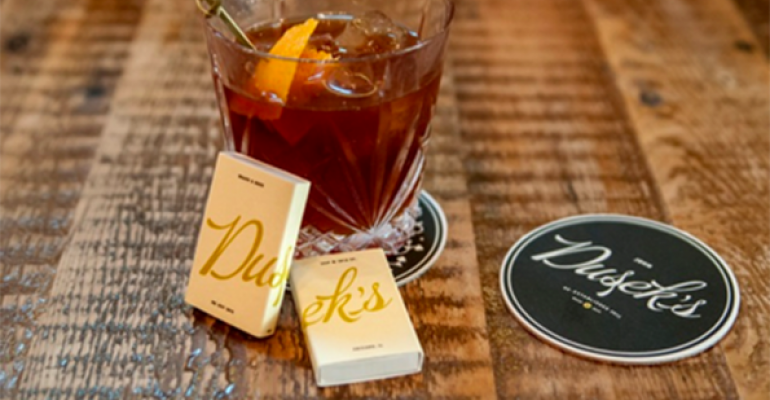Where are drink trends going? Some new information and observations on wine, beer and cocktails can spark creativity and help your beverage program attract more customers.
Beverage consultants Uncorkd found that many consumers consider the quality and breadth of drink offerings important factors when they choose a restaurant. Still, there’s plenty of room for growth when it comes to alcohol sales: 30 percent of respondents replied “almost never” when asked how often they order alcoholic beverages when dining in restaurants that serve alcohol. Another 15 percent replied “rarely” to the same question.
How can you get more patrons to raise a glass?
The alcoholic beverage most commonly consumed in restaurants, not surprisingly, is wine, (36 percent, followed by beer, 33 percent, and spirits, 30 percent.) The Uncorkd consultants say their survey responses unveiled four key ways a restaurant can up their wine game and drive sales:
1. Have more tasting notes and food pairing suggestions to help your guests select a wine. Describing color and including reviews and ratings also help consumers feel more confident about choosing wine.
2. Allow guests to try samples before they buy. Survey respondents said uncertainty is the number one reason people do not purchase wine.
3. Offer different size pours.
4. Offer more local wines, more bottles at lower price points and more by-the-glass selections.
When it comes to beer, the Uncorkd survey revealed that while 43 percent of women prefer wine in a restaurant, compared to 21 percent of men, 21 percent of women call beer their preferred drink, and 49 percent of men do as well. Beer becomes an increasingly popular choice as one moves inland, compared to the coasts, where wine is the preferred restaurant beverage. Age demographics impact beer sales, too, with younger drinkers preferring beer over wine by a ratio of 2 to 1.
How do guests choose a brew? It turns out that beer style (IPA, pale ale, stout, etc.) and brand/brewery were the most important factors to beer drinkers.
On the cocktail front, blogger Merilee Kern of The Luxe List has identified “game-changing cocktail trends” that include:
1. More playfulness, less pretense. “Severe” and serious mixology is giving way to cheeky and whimsical spirits and concoctions. Buzzwords like “homespun” and “laid-back” represent an important niche going forward.
2. Simplicity reigns supreme. “Gone are the days of overzealous mixologists [with] something to prove, taking 15 minutes or more to perfect a drink,” writes Kern. Instead, “simplified elixirs are at the forefront that require few ingredients and/or steps of preparation to create a killer craft cocktail.” Going along with this is a trend toward handcrafted manufacturing: Leading-edge producers are differentiating themselves and commanding higher price points with personal techniques like hand-zesting lemons and writing their bottle labels by hand.
3. Simple glassware, too. A current “penchant for nostalgia” is putting more mason jars and other vintage and vintage-inspired drinking glasses on bars.
4. Moonshine is back. Distillers are getting creative with this novelty throwback spirit and making handcrafted, upscale products with a nostalgic bent. Other prohibition-era elixirs remain strong as well. Recipes (like the Old Fashioned, Jack and Rose, Sidecar, Classic Gimlet and Pink Lady) that use distinctive savory, bitter or sweet ingredients of the era such as grenadine, whiskey, gin and bitters can pique guests' imaginations.
5. Increasing culinary influences. In addition to fresh fruits and juices, root, nut and herb-laden drinks are popping up on menus. “Locavore libations,” made with fresh, locally grown ingredients and eschewing preservatives, concentrates and artificial ingredients, are being well received. Distillers are also paying attention to ingredients, emphasizing 100 percent natural ingredients grown on their own or nearby farms for artisan spirits and liquors.
Technomic’s Anne Mills notes that unique adult beverages can win favor with today’s younger consumers in particular, as they “are generally more adventurous in their dining habits compared to their older counterparts…Their desire and curiosity to try new flavors and ingredients continues even after they find a drink they enjoy,” writes Mills.
Among those adventurous drinks are wine and beer cocktails (winetails and beertails), which can “drive traffic among not only younger consumers but also those who enjoy wine or beer with a twist.”
Examples include:
• “Midnight Kiss.” Cassis and Champagne topped with Guinness (Elephant & Castle restaurants)
• “Last Great Wine Thief.” Plymouth gin, Sauvignon Blanc and clover honey with hopped grapefruit bitters (NoRTH Italia restaurants)
• “Ruby and Ginger.” Sandeman Reserve Port wine and Reed’s Premium ginger ale, served over ice with a lime twist. (Pinstripes restaurants)
How do you reach those young consumers who will punch up your bar sales? The Uncorkd survey found that younger consumers (21-40) are twice as likely to engage in social media during their restaurant visit than older consumers. “For restaurant operators, this means having a social media presence can help increase popularity with Millennials,” the report authors advise. Yes, you need a killer beverage menu, but you also need get the word out and, for Millennials, you can’t do this without social media.
Contact Gina Ragone at [email protected]





